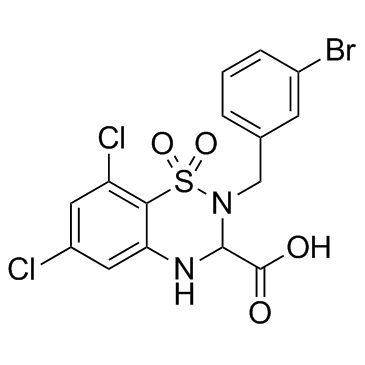RPR104632 |
| Catalog No.GC31039 |
RPR104632는 강력한 신경 보호 특성을 가진 NMDA 수용체의 특정 길항제입니다.
Products are for research use only. Not for human use. We do not sell to patients.

Cas No.: 154106-92-0
Sample solution is provided at 25 µL, 10mM.
RPR104632 is a specific antagonist of NMDA receptor, with potent neuroprotective properties.
RPR104632 antagonizes the binding of [3H]5,7-dichlorokynurenic acid to the rat cerebral cortex, with a Ki of 4.9 nM. RPR104632 inhibits [3H]N-[1-(2-thienyl)cyclohexyl]-3,4-piperidine ([3H]TCP) binding in the presence of N-methyl-D-aspartate (NMDA) (IC50 = 55 nM). RPR104632 inhibits the NMDA-evoked increase in guanosine 3',5'-cyclic monophosphate (cGMP) levels of neonatal rat cerebellar slices (IC50 = 890 nM) in a non-competitive manner and markedly reduces NMDA-induced neurotoxicity in rat hippocampal slices and in cortical primary cell cultures. MK-801 (1 μM) completely protects the CA1 and CA3 pyramidal neurones against NMDA-induced toxicity, but these effects are not blocked by glycine. RPR104632 produces a significant and consistent neuroprotective effect towards all the NMDA-induced toxicity and has no effect when it is added alone at concentrations up to 10 μM. RPR104632 has neuroprotective potencies, with EC50 of 4 μM[1].
[1]. Boireau A, et al. Neuroprotective effects of RPR 104632, a novel antagonist at the glycine site of the NMDA receptor, in vitro. Eur J Pharmacol. 1996 Apr 11;300(3):237-46.
| Cas No. | 154106-92-0 | SDF | |
| Canonical SMILES | O=C(C(NC1=CC(Cl)=CC(Cl)=C12)N(CC3=CC=CC(Br)=C3)S2(=O)=O)O | ||
| Formula | C15H11BrCl2N2O4S | M.Wt | 466.13 |
| Solubility | Soluble in DMSO | Storage | Store at -20°C |
| General tips | Please select the appropriate solvent to prepare the stock solution according to the
solubility of the product in different solvents; once the solution is prepared, please store it in
separate packages to avoid product failure caused by repeated freezing and thawing.Storage method
and period of the stock solution: When stored at -80°C, please use it within 6 months; when stored
at -20°C, please use it within 1 month. To increase solubility, heat the tube to 37°C and then oscillate in an ultrasonic bath for some time. |
||
| Shipping Condition | Evaluation sample solution: shipped with blue ice. All other sizes available: with RT, or with Blue Ice upon request. | ||
| Prepare stock solution | |||

|
1 mg | 5 mg | 10 mg |
| 1 mM | 2.1453 mL | 10.7266 mL | 21.4532 mL |
| 5 mM | 0.4291 mL | 2.1453 mL | 4.2906 mL |
| 10 mM | 0.2145 mL | 1.0727 mL | 2.1453 mL |
Step 1: Enter information below (Recommended: An additional animal making an allowance for loss during the experiment)
 g
g
 μL
μL

Step 2: Enter the in vivo formulation (This is only the calculator, not formulation. Please contact us first if there is no in vivo formulation at the solubility Section.)
Calculation results:
Working concentration: mg/ml;
Method for preparing DMSO master liquid: mg drug pre-dissolved in μL DMSO ( Master liquid concentration mg/mL, Please contact us first if the concentration exceeds the DMSO solubility of the batch of drug. )
Method for preparing in vivo formulation: Take μL DMSO master liquid, next addμL PEG300, mix and clarify, next addμL Tween 80, mix and clarify, next add μL ddH2O, mix and clarify.
Method for preparing in vivo formulation: Take μL DMSO master liquid, next add μL Corn oil, mix and clarify.
Note: 1. Please make sure the liquid is clear before adding the next solvent.
2. Be sure to add the solvent(s) in order. You must ensure that the solution obtained, in the previous addition, is a clear solution before proceeding to add the next solvent. Physical methods such as vortex, ultrasound or hot water bath can be used to aid dissolving.
3. All of the above co-solvents are available for purchase on the GlpBio website.
Quality Control & SDS
- View current batch:
- Purity: >98.00%
- COA (Certificate Of Analysis)
- SDS (Safety Data Sheet)
- Datasheet
Average Rating: 5 (Based on Reviews and 16 reference(s) in Google Scholar.)
GLPBIO products are for RESEARCH USE ONLY. Please make sure your review or question is research based.
Required fields are marked with *



















